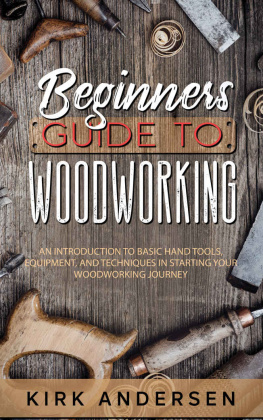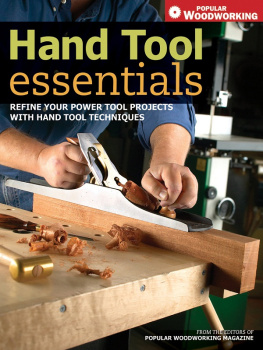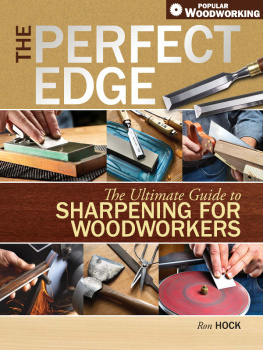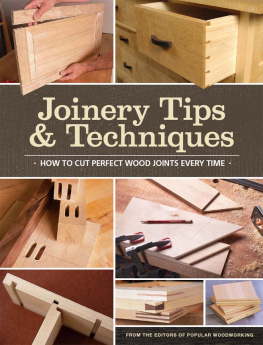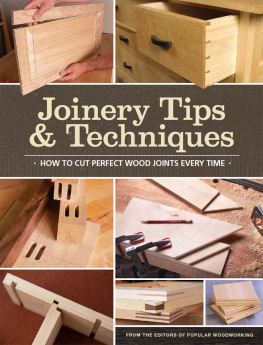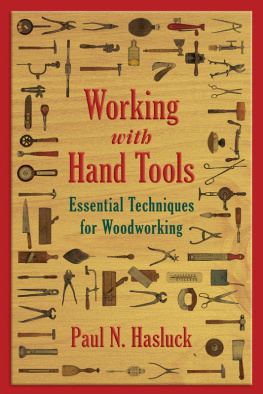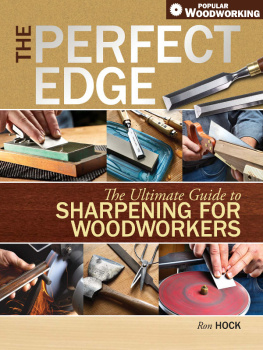Thank you for purchasing this Popular Woodworking eBook.
Sign up for our newsletter and receive special offers, access to free content, and information on the latest new releases and must-have woodworking resources! Plus, receive a coupon code to use on your first purchase from ShopWoodworking.com for signing up.
or visit us online to sign up at
http://popularwoodworking.com/ebook-promo
CONTENTS
CHAPTER 1
CHAPTER 2
CHAPTER 3
CHAPTER 4
CHAPTER 5
CHAPTER 6
CHAPTER 7
INTRODUCTION
WHY HAND TOOLS?
Im going to show you how to do all of your woodworking with hand tools. Some may ask, Why do that when we have power tools available?
One practical reason that quickly comes to mind is access. If you dont have access to power tools because of lack of money or space constraints (or if you are hesitant to use them because of noise or dust), you can do the same work with hand tools.
There are plenty of other reasons to use hand tools as well, including enjoyment of the craft. Hand tools can be a lot of fun and it is very satisfying to build something entirely with your hands. And even if you dont want to do everything with hand tools, you can incorporate some of these hand techniques into your machine work.
DIFFERENT WAYS OF DOING THINGS
There are a variety of different ways to do things and they have evolved over time. Woodworking has been practiced all over the world, so some methods are regional, some show the influence of specific teachers and schools.
The important thing to remember is that the proven methods all work, even though some of them may seem contrary to one another. Craftsmen have been successful using them in their woodworking for decades.
The methods I show here are based primarily in the English and North American traditions. These are referred to as Western style Asian traditions are referred to as Eastern styles. Even among Western styles, there are distinctions between British and continental European styles, just as there are further distinctions among the various Asian styles.
The main differences in these regional styles are reflected in the tools. For instance, Western saws typically work on the push stroke, while Eastern saws work on the pull stroke. There are also differences in techniques.
Everything Ill show you has a long history. There might be some modern variations or versions of the tools, but they all have hundreds of years of history behind them.
Knowing multiple methods allows you to be more versatile. Then you can adapt to different situations based on the tools you have at hand or the particular project that youre working on.
Flexibility is key. You might be able to do 90 percent of a job the same way, but have to vary it for the last little bit. Consistency leads to efficiency, but dont allow yourself to get so set on being consistent that you cant use an alternative method when necessary.
People tend to have very strong feelings about the different ways of doing things, so Ill go over the fist fights and fundamentals of woodworking. These are the various arguments about whether to do things one way or another.
Ill outline what the argument is about and break down the fundamentals of the methods to examine why they work. Then you can decide what appeals to you the most and what is appropriate for your tools and situation.
SETTING UP
I use a variety of antique and new hand tools in my work. The specific tools youll use will likely depend on cost and availability.
The cost to set up a hand tool workshop ranges from $500 to $1,000 to get started. You can always spend more money, but thats enough to get you tools, a sharpening system, a workbench, various workbench appliances and everything you need to do all the basic operations. From there you can go into more specialized tools and your investment will really start to add up.
One of the other interesting things about a hand tool workshop is that you really only need a minimum of a 4'x6' space. That means you can work on a porch, in a spare room, in a corner of a room, under a stair, in a garden shed or in the backyard.
More space is always nice, but you can easily set up a functional hand tool workshop almost anywhere, even if you live in a small apartment.
PRACTICE
Learning to work with hand tools is a lot like learning to play a musical instrument. It takes practice.
Imagine learning how to play the guitar. You have to learn how to tune the guitar, where to put your fingers on the neck to form notes and chords, and how to pick or strum the strings. Then you have to develop the muscle memory to make these skills work.
Your instructor can pour information into your head all day, but until you spend some time practicing, you wont be able to play your instrument.
Similarly with hand tools, you need to put in the time to develop the hand skills. You need to practice and accept that youre going to make a lot of mistakes. Dont worry about it. The best attitude is that there are no mistakes here; there are only learning opportunities.
MATERIALS
For your learning materials, start out with softwoods that are easy to work, such as Eastern white pine. Dont start with the hardwoods immediately. Use something thats relatively soft and is cheap, plentiful and easy to find in your part of the country.
The main advantage of starting with softwoods is that theyll fight you a lot less. You already have plenty of things to deal with in learning how to handle and control the tools, so dont add the wood to that fight.
Later you can move on to hardwoods, like cherry, walnut, maple, oak and mahogany. Youll find that working different kinds of woods generally requires relearning the skills just a little bit, because each wood responds to the tools and techniques somewhat differently.
Lumber straight from the sawmill is called rough-milled. Rough-milled lumber that is then planed on top and bottom is called S2S, for surfaced 2 sides. This leaves rough edges. S2S lumber that is then trimmed to width on both edges is called S4S, for surfaced 4 sides.
Lumber must also be dried to a controlled moisture content. It may be air-dried in the open or in sheds for long periods, or kiln-dried in large kilns for short periods (often labeled KD).
Sawmills and lumberyards typically sell rough-milled, S2S and S4S, both air-dried and KD. Home centers generally only sell S4S KD.
The cost of a given species of lumber depends on how much work has gone into processing it. Rough-milled is the cheapest, followed by S2S and S4S. Its labeled and sold according to its rough-milled thickness and width. Surfacing then reduces those to finished dimensions.
Rough-milled thickness is measured in quarter-inches, such as 4/4, 6/4, and 8/4, for 1", 112", and 2" material. Planing consumes 14" and trimming to width generally consumes 12", so when you buy S4S stock labeled as 1"x6", its actually 34" thick by 512" wide. When you buy rough-milled stock, you should expect to remove the same amount of thickness and width yourself.




